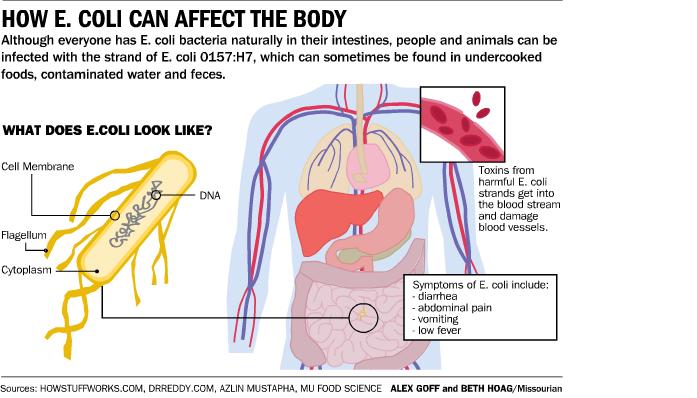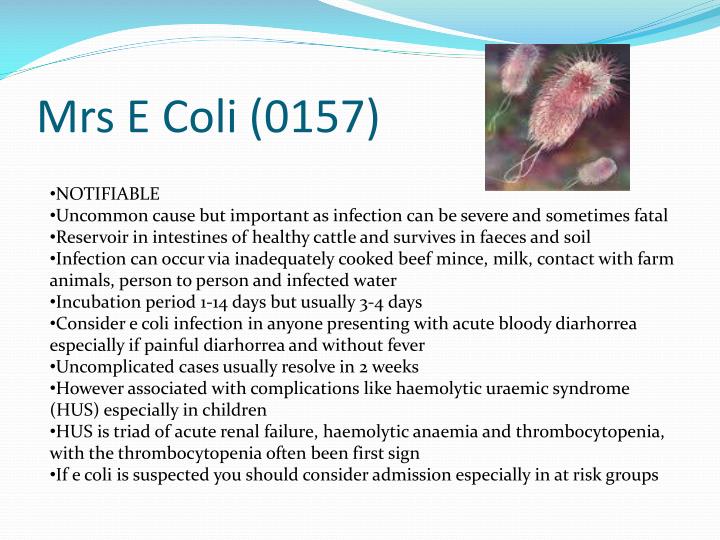Symptoms of e. coli 0157. E. coli O157:H7 Infection: Symptoms, Risks, and Prevention Strategies
What are the main symptoms of E. coli O157:H7 infection. How is E. coli O157:H7 transmitted. What are the most effective ways to prevent E. coli O157:H7 infection. Who is at highest risk for developing complications from E. coli O157:H7. How is E. coli O157:H7 infection diagnosed and treated. What food safety practices can reduce the risk of E. coli contamination. When should medical attention be sought for suspected E. coli infection.
Understanding E. coli O157:H7: A Potentially Dangerous Bacterial Strain
Escherichia coli O157:H7 (E. coli O157:H7) is a specific strain of bacteria that can cause severe illness in humans. While many E. coli strains are harmless and even beneficial, E. coli O157:H7 produces a powerful toxin that can lead to serious health complications. This strain is part of a group called Shiga toxin-producing E. coli (STEC), named after the toxin it produces.
E. coli O157:H7 was first identified as a pathogen in 1982 during an outbreak investigation of hemorrhagic colitis. Since then, it has been recognized as a significant public health concern due to its ability to cause severe gastrointestinal illness and potentially life-threatening complications.

Where does E. coli O157:H7 come from?
E. coli O157:H7 primarily resides in the intestines of cattle and other ruminants. These animals can carry the bacteria without showing any signs of illness, acting as reservoirs for human infection. The bacteria can contaminate meat during slaughter and processing, particularly ground beef. Additionally, produce can become contaminated if it comes into contact with animal feces or contaminated water.
Recognizing the Symptoms of E. coli O157:H7 Infection
Identifying an E. coli O157:H7 infection early is crucial for proper management and preventing potential complications. The symptoms typically appear 2 to 5 days after exposure to the bacteria, although this incubation period can range from 1 to 10 days.
What are the primary symptoms of E. coli O157:H7 infection?
- Severe abdominal cramps
- Diarrhea, often bloody
- Nausea
- Vomiting (less common)
- Mild fever (in some cases)
It’s important to note that while most people infected with E. coli O157:H7 experience diarrhea, the absence of fever is common. This distinguishes it from many other gastrointestinal infections. In some cases, individuals may be asymptomatic carriers, capable of spreading the bacteria without showing any signs of illness themselves.
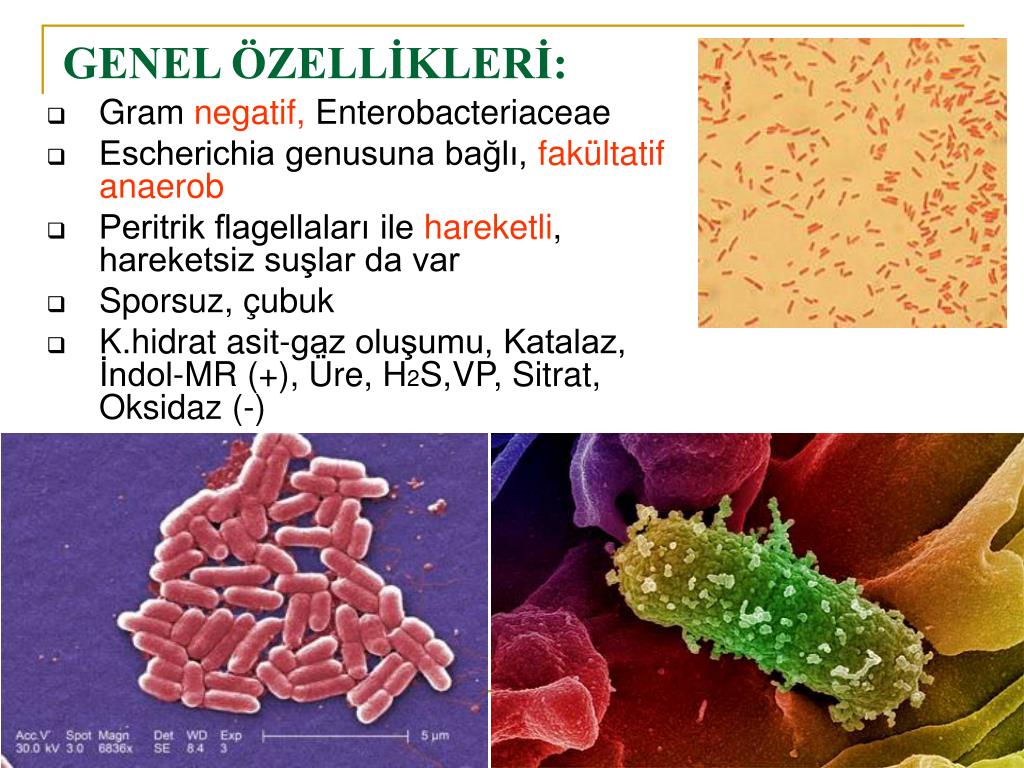
How long do E. coli O157:H7 symptoms typically last?
The duration of symptoms can vary, but most people recover within 5 to 10 days. However, in severe cases or when complications arise, the illness can persist longer and may require hospitalization.
Transmission Routes: How E. coli O157:H7 Spreads
Understanding how E. coli O157:H7 spreads is crucial for implementing effective prevention strategies. The bacteria can be transmitted through various routes, all of which involve some form of fecal-oral transmission.
What are the main ways E. coli O157:H7 is transmitted?
- Contaminated food: Consuming undercooked ground beef, raw produce, or unpasteurized dairy products
- Contaminated water: Drinking or swallowing untreated water from lakes, rivers, or contaminated water supplies
- Person-to-person contact: Direct contact with an infected person, especially in settings like daycare centers or nursing homes
- Animal contact: Touching animals carrying the bacteria, particularly at petting zoos or farms
- Environmental contamination: Contact with surfaces or objects that have been contaminated with the bacteria
The infectious dose of E. coli O157:H7 is remarkably low, with as few as 10 to 100 organisms capable of causing infection. This low infectious dose contributes to the ease of transmission and the potential for outbreaks.
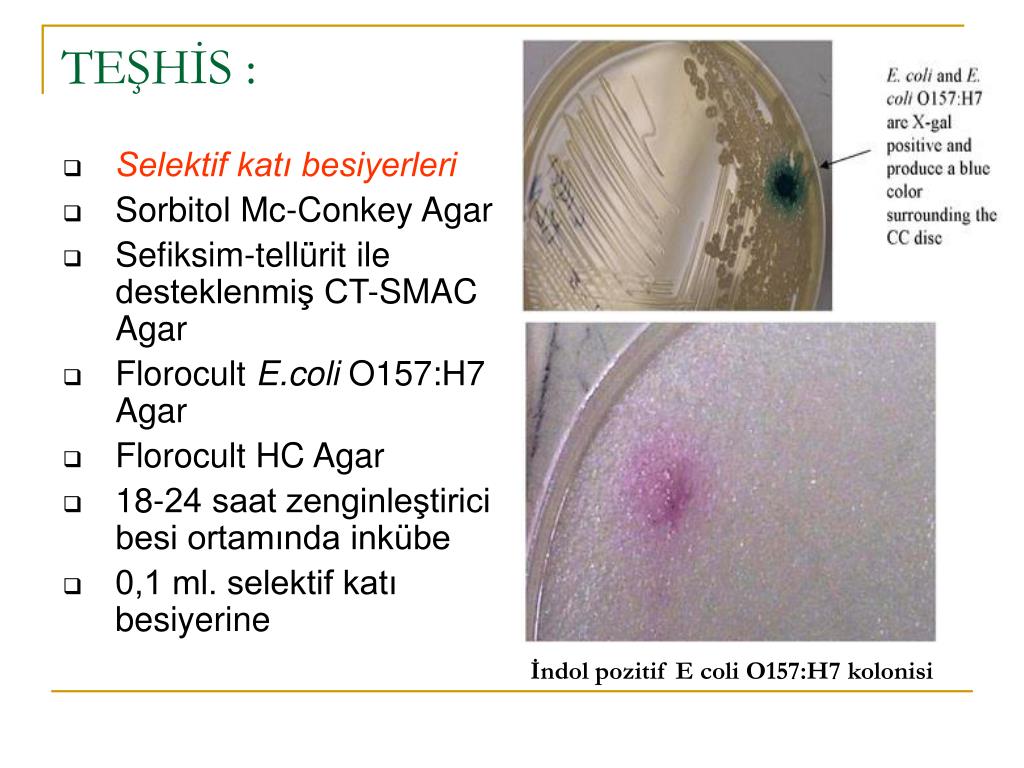
High-Risk Groups and Potential Complications
While anyone can become infected with E. coli O157:H7, certain groups are at higher risk for severe illness and complications. Understanding these risk factors is essential for targeted prevention and early intervention strategies.
Who is most vulnerable to severe E. coli O157:H7 infections?
- Young children (under 5 years old)
- Elderly individuals (over 65 years old)
- People with weakened immune systems
- Pregnant women
These groups are not only more susceptible to infection but also at higher risk for developing serious complications, such as Hemolytic Uremic Syndrome (HUS).
What is Hemolytic Uremic Syndrome (HUS)?
HUS is a potentially life-threatening complication that occurs in about 5-10% of E. coli O157:H7 infections, particularly in children. It develops when the Shiga toxin produced by the bacteria damages red blood cells and the lining of blood vessels, especially in the kidneys.
Symptoms of HUS typically appear 5-10 days after the onset of diarrhea and may include:

- Decreased urine output
- Fatigue and pallor due to anemia
- Small, unexplained bruises or bleeding
- Swelling of the face, hands, or feet
- Confusion or seizures (in severe cases)
HUS can lead to kidney failure, neurological complications, and in some cases, death. Prompt medical attention is crucial if HUS is suspected.
Diagnosis and Treatment of E. coli O157:H7 Infections
Accurate diagnosis and appropriate treatment are crucial for managing E. coli O157:H7 infections and preventing complications. Healthcare providers use a combination of clinical evaluation and laboratory tests to confirm the diagnosis.
How is E. coli O157:H7 infection diagnosed?
Diagnosis typically involves:
- Medical history and physical examination
- Stool sample analysis to identify the presence of E. coli O157:H7
- Blood tests to check for signs of dehydration, inflammation, or organ damage
- In some cases, additional tests like colonoscopy or imaging studies may be necessary
Rapid diagnostic tests are available in many healthcare settings, allowing for quick identification of the bacteria and prompt initiation of appropriate treatment.

What is the recommended treatment for E. coli O157:H7 infections?
Treatment for E. coli O157:H7 infections is primarily supportive, focusing on managing symptoms and preventing complications. Key aspects of treatment include:
- Hydration: Replacing fluids and electrolytes lost due to diarrhea
- Rest: Allowing the body to recover and fight the infection
- Monitoring: Close observation for signs of complications, especially in high-risk individuals
- Avoidance of certain medications: Antibiotics and anti-diarrheal agents are generally not recommended as they may increase the risk of complications
In severe cases or when complications like HUS develop, hospitalization may be necessary for intensive supportive care, including intravenous fluids, blood transfusions, or dialysis.
Prevention Strategies: Safeguarding Against E. coli O157:H7
Preventing E. coli O157:H7 infections requires a multi-faceted approach that addresses various potential sources of contamination. By implementing proper hygiene practices, food safety measures, and environmental controls, the risk of infection can be significantly reduced.

What are the most effective ways to prevent E. coli O157:H7 infection?
- Hand hygiene:
- Wash hands thoroughly with soap and water for at least 20 seconds, especially after using the bathroom, changing diapers, before preparing or eating food, and after contact with animals
- Use hand sanitizer when soap and water are not available
- Food safety:
- Cook ground beef to an internal temperature of at least 160°F (71°C)
- Avoid consuming raw or unpasteurized dairy products
- Wash fruits and vegetables thoroughly before eating
- Prevent cross-contamination by separating raw meats from other foods and using separate cutting boards
- Water safety:
- Drink only treated or boiled water, especially when traveling
- Avoid swallowing water while swimming in lakes, ponds, or pools
- Animal contact:
- Wash hands after contact with animals, especially at farms or petting zoos
- Supervise young children around animals to prevent hand-to-mouth contact
- Environmental hygiene:
- Clean and disinfect surfaces regularly, especially in bathrooms and kitchens
- Properly dispose of diapers and sanitize changing areas
By incorporating these preventive measures into daily routines, individuals and communities can significantly reduce the risk of E. coli O157:H7 infections.

E. coli O157:H7 Outbreaks: Lessons Learned and Public Health Response
E. coli O157:H7 outbreaks have played a crucial role in shaping our understanding of the bacteria and improving public health responses. These incidents have led to significant changes in food safety regulations, agricultural practices, and public awareness.
What can we learn from past E. coli O157:H7 outbreaks?
Several key lessons have emerged from major outbreaks:
- The importance of rapid detection and reporting systems
- The need for stringent food safety protocols throughout the supply chain
- The value of public education on food handling and hygiene practices
- The critical role of collaborative efforts between public health agencies, food producers, and retailers
One notable example is the 1993 Jack in the Box outbreak, which led to significant changes in the food service industry and USDA regulations regarding the cooking temperature of ground beef.
How do public health agencies respond to E. coli O157:H7 outbreaks?
When an outbreak is suspected or confirmed, public health agencies typically follow a structured response plan:

- Outbreak detection: Identifying clusters of cases through surveillance systems
- Investigation: Conducting interviews with affected individuals and tracing potential sources
- Laboratory analysis: Confirming the presence of E. coli O157:H7 and identifying its genetic fingerprint
- Implementation of control measures: Recalling contaminated products, closing implicated facilities, or issuing public health advisories
- Communication: Providing timely and accurate information to the public and healthcare providers
- Follow-up: Monitoring the effectiveness of interventions and implementing long-term prevention strategies
These coordinated efforts aim to contain outbreaks quickly and prevent further cases of illness.
Emerging Research and Future Directions in E. coli O157:H7 Management
The field of E. coli O157:H7 research is dynamic, with ongoing studies aimed at improving prevention, detection, and treatment strategies. These efforts are crucial for reducing the burden of illness associated with this pathogen.

What are some promising areas of research in E. coli O157:H7 management?
- Vaccine development: Researchers are exploring potential vaccines for both humans and cattle to prevent E. coli O157:H7 infections
- Novel detection methods: Rapid and sensitive diagnostic tools are being developed to improve outbreak detection and response times
- Alternative treatment approaches: Studies are investigating new therapies that could neutralize the Shiga toxin or prevent its harmful effects
- Microbiome research: Understanding how the gut microbiome influences susceptibility to E. coli O157:H7 infection and severity of illness
- Genetic studies: Identifying genetic factors that may increase or decrease an individual’s risk of severe complications like HUS
These research directions hold promise for enhancing our ability to prevent, detect, and treat E. coli O157:H7 infections more effectively in the future.
How might climate change impact the prevalence of E. coli O157:H7?
Climate change could potentially affect the prevalence and distribution of E. coli O157:H7 in several ways:

- Altered rainfall patterns may increase the risk of water contamination
- Higher temperatures could affect bacterial growth rates and survival in the environment
- Changes in agricultural practices in response to climate shifts may influence the ecology of E. coli O157:H7 in animal reservoirs
- Extreme weather events could disrupt food supply chains and increase the risk of contamination
Ongoing research is essential to understand and mitigate these potential impacts, ensuring that public health strategies remain effective in the face of environmental changes.
E. coli O157:H7 and HUS Fact Sheet
Revised May 2009
Download a print version of this document:
E. coli O157:H7 and HUS Fact Sheet (PDF)
What is it?
Escherichia coli O157:H7 (E. coli O157) is one of hundreds of strains of the bacterium Escherichia coli. Most strains of E. coli are harmless and live in the intestines of healthy humans and animals. However, the O157 strain produces a powerful toxin that can cause severe illness.
What are the symptoms?
Symptoms of E. coli O157 infection include severe diarrhea (often bloody) and abdominal cramps. Most people infected with E. coli O157 do not have a fever or vomiting.
Symptoms usually begin 2 to 5 days after exposure to the bacteria. Sometimes people infected with E. coli O157 have no symptoms at all, but can still pass the bacteria to others.
In some people, especially in children under 5 years old and the elderly, E. coli O157 infections can cause a complication called Hemolytic Uremic Syndrome (HUS). About 2 – 7% of E. coli O157 infections lead to HUS. HUS occurs when the E. coli O157 toxin destroys red blood cells. HUS can lead to kidney failure, neurologic damage, and in some cases, death. Approximately 5 – 10% of HUS cases are fatal.
coli O157 infections can cause a complication called Hemolytic Uremic Syndrome (HUS). About 2 – 7% of E. coli O157 infections lead to HUS. HUS occurs when the E. coli O157 toxin destroys red blood cells. HUS can lead to kidney failure, neurologic damage, and in some cases, death. Approximately 5 – 10% of HUS cases are fatal.
How long does it last?
Symptoms usually last 5 to 10 days. People with mild symptoms usually recover on their own without treatment. Antibiotics are not helpful for treating E. coli O157 infections, and may even increase the likelihood of developing HUS. Antidiarrheal agents should not be used either.
How is it spread?
E. coli O157 lives in the intestines of healthy cattle and other animals. E. coli O157 can be found in water, food, soil, or on surfaces that have been contaminated with animal or human feces. Family members and playmates of children infected with E. coli O157are at high risk of becoming infected.
People can become infected by:
- Eating contaminated food, such as:
- undercooked hamburger
- raw produce items, such as sprouts and lettuce
- Drinking unpasteurized milk, juice, or cider.
- Swallowing recreational water contaminated with E. coli O157 (recreational water includes lakes, streams, rivers, springs, ponds, swimming pools, hot tubs, Jacuzzis, and water park fountains).
- Contact with farm animals or pets.
- Touching contaminated surfaces or objects and then touching their mouth or putting a contaminated object into their mouth.
- Not washing hands after using the bathroom or changing diapers and then eating foods.
What should I do if I have symptoms?
- Contact your health care provider. Note that antibiotic treatment is not helpful for E. coli O157 infections, and may be harmful in some cases.
- Wash your hands often.
- Do not send your child to daycare or preschool if he or she has diarrhea.

How can I prevent
E. coli infections?
- Wash your hands with warm, soapy water for at least 20 seconds
- After using the bathroom
- After changing diapers
- After contact with animals or their environment
- Before eating
- Supervise young children to be sure they properly wash their hands.
- Wash your hands more often when someone in your household is sick.
- Cook all ground beef and hamburger products to at least 160°F. Do not eat hamburgers if they are pink in the middle.
- Prevent cross-contamination in the kitchen by washing hands, cutting boards, countertops, knives, utensils, and surfaces with warm, soapy water after handling raw foods.
- Separate raw meats, poultry, and seafood from vegetables and cooked foods.
- Wash and/or peel fruits and vegetables before eating them.
- Do not drink unpasteurized milk, juice, or cider.
- Clean and disinfect surfaces with household bleach immediately after vomiting or diarrheal accidents.

- Don’t drink untreated water from lakes, rivers, streams, ponds, or shallow wells.
Healthy Swimming Tips:
- Do not swallow water or get water in your mouth while swimming.
- Take a shower before and after swimming.
- Do not swim when you have diarrhea.
- When swimming, take your kids on frequent bathroom breaks – waiting to hear “I have to go” may mean that it’s already too late.
- Change diapers in changing rooms, not poolside or on the beach. Wash hands after changing diapers.
Escherichia coli O157:H7 | Johns Hopkins Medicine
What is E. coli O157:H7?
Escherichia coli (or simply E. coli) is one of the many groups of bacteria
that live in the intestines of healthy humans and most warm-blooded
animals. E. coli bacteria help maintain the balance of normal intestinal
flora (bacteria) against harmful bacteria and synthesize or produce some
vitamins.
However, there are hundreds of types or strains of E.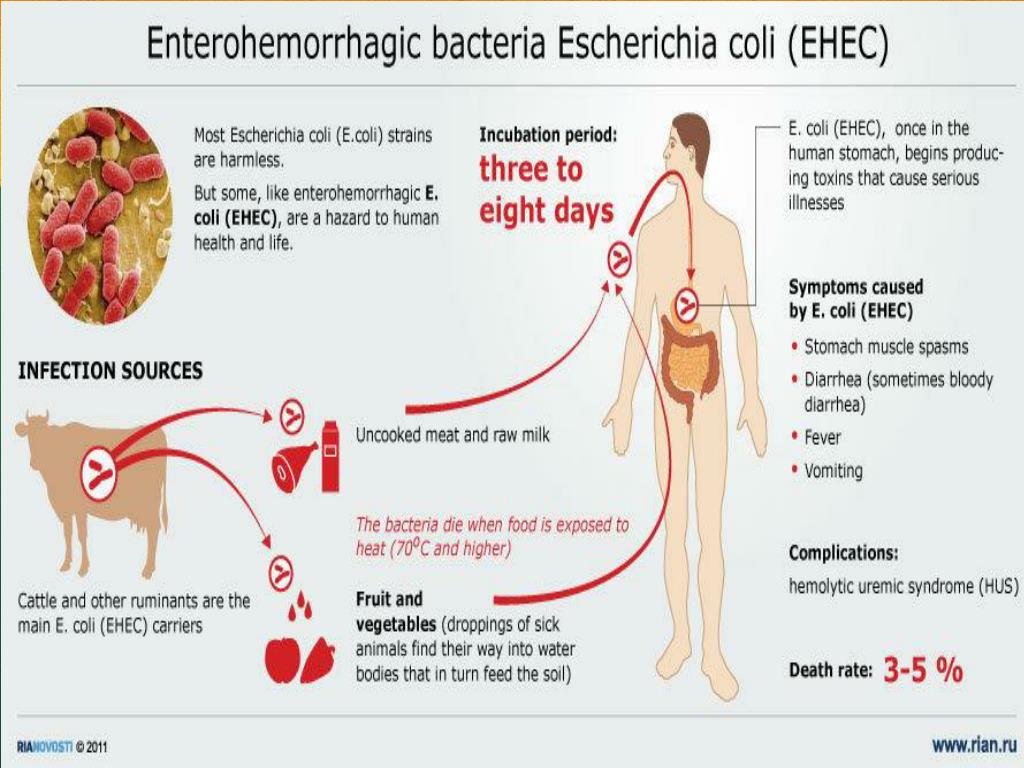 coli bacteria.
coli bacteria.
Different strains of E. coli have different distinguishing characteristics.
A particular strain of E. coli known as E. coli O157:H7 causes a severe
intestinal infection in humans. It is the most common strain to cause
illness in people. It can be differentiated from other E. coli by the
production of a potent toxin that damages the lining of the intestinal wall
causing bloody diarrhea. It is also known as enterohemorrhagic E. coli
infection.
The Centers for Disease Control and Prevention (CDC) reports about 70,000
cases of this type of E. coli infection occur in the United States each
year.
How is the E. coli infection spread?
In 1982, E. coli O157:H7 was initially identified as the cause of bloody
diarrhea from eating undercooked or raw hamburger meat that was
contaminated with the bacteria. Since that time, outbreaks of E. coli
O157:H7 have been associated with other types of foods such as spinach,
lettuce, sprouts, unpasteurized milk, apple juice, apple cider, salami, and
well water or surface water areas frequently visited by animals.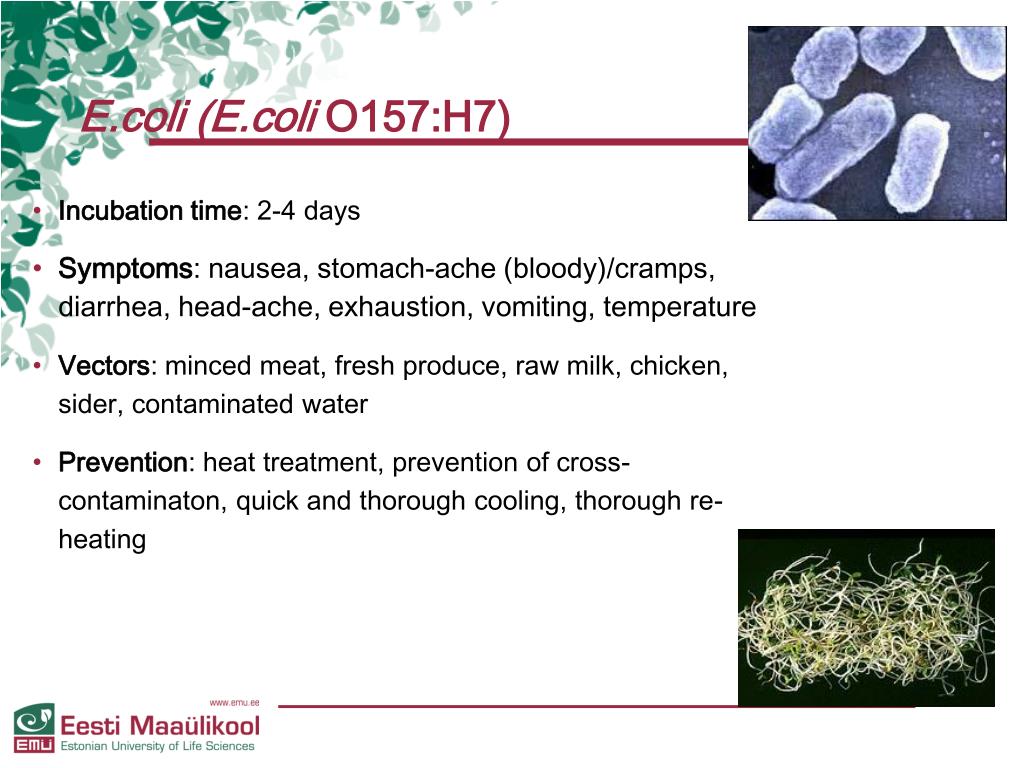 Outbreaks
Outbreaks
have also been traced to animals at petting zoos and day care centers.
E. coli O157:7 is found in the intestines of healthy cattle, goats, deer,
and sheep. According to the CDC, the transmission of these bacteria to
humans may occur in the following manner:
Meat, such as beef from cows, may become contaminated when
organisms are accidently mixed in with beef, especially when it is
ground. Meat contaminated with E. coli O157:H7 does not smell and
looks normal. It is important to thoroughly cook beef.Infection may occur after swimming in or drinking water that has
been contaminated with E. coli O157:H7.The bacteria can also be transmitted from person-to-person in
families and in child care and other institutional care centers.
However, the CDC also indicates the way E. coli O157:H7 is transmitted may
change over time.
What are the symptoms of an E. coli infection?
An E. coli infection can make a person very ill. Symptoms usually begin two
to five days after ingesting contaminated foods or liquids, and may last
for eight days. The following are some of the most common symptoms
associated with E. coli O157:H7. However, each person may experience
symptoms differently:
Symptoms may range from none to HUS. In HUS, an individual’s red blood
cells (oxygen-carrying cells in the bloodstream) are destroyed and the
kidneys stop working. Approximately 8 percent of infections can result in
this syndrome. Children and the elderly may be more prone to develop this
complication, which may be life-threatening.
How is E. coli O157:H7 diagnosed?
E. coli O157:H7 can be confirmed with a special stool culture. Stool
samples are tested to compare with the source or contaminated food that has
caused an outbreak. The CDC calls this “DNA fingerprinting” of E. coli.
What is the treatment for an E.
 coli infection?
coli infection?
Antibiotics are not used with this type of infection, and taking them may
increase the risk of HUS. In addition, antidiarrheal medications, such as
loperamide (Imodium) are not used. Recovery for most people with this
illness usually occurs within five to 10 days.
If a person develops HUS, hospitalization in an intensive care unit may be
required. Treatment may include blood transfusions and kidney dialysis.
According to the CDC, three to five percent of persons who develop HUS may
die from this complication.
How can an E. coli infection be prevented?
CDC recommendations for prevention of the infection include:
Cook all ground beef, pork, sheep meat, or sausage thoroughly. Make
sure that the cooked meat is gray or brown throughout (not pink),
any juices run clear, and the inside is hot.Use a digital instant-read meat thermometer to make sure the
temperature of the meat has reached a minimum of 160 degrees F.
If you are served an undercooked hamburger in a restaurant, send it
back.Wash all vegetables and fruits with water, especially if you do not
plan to cook them.Consume only pasteurized milk and milk products. Avoid raw milk.
Consume only pasteurized juices and ciders.
Keep raw meat separate from ready-to-eat foods.
Make sure that infected persons, especially children, wash their
hands carefully and frequently with soap to reduce the risk of
spreading the infection.Drink municipal water that has been treated with adequate levels of
chlorine, or other effective disinfectants.Avoid swallowing lake or pool water while swimming.
Wash hands thoroughly after using the toilet.

Wash hands thoroughly after handling animals, animal bedding, or
any material contaminated with animal feces.People with diarrhea should not:
“There will be a stick in any rolls.” Which intestinal infections are dangerous for health and which ones are beneficial? Should I stop eating rolls?
– E. coli bacteria include more than 100 types of microorganisms. Among them are dangerous – that is, they can potentially cause disease – and there are many non-pathogenic or opportunistic pathogens. There is also E. coli, which, on the contrary, is beneficial for microflora. There are even drugs with Escherichia coli that can be used in case of dysbacteriosis.
In Russia, the standard for bacteria of the Escherichia coli group is stricter than in European and world approaches. They have an emphasis on one of the species that is clearly pathogenic – Escherichia coli O157.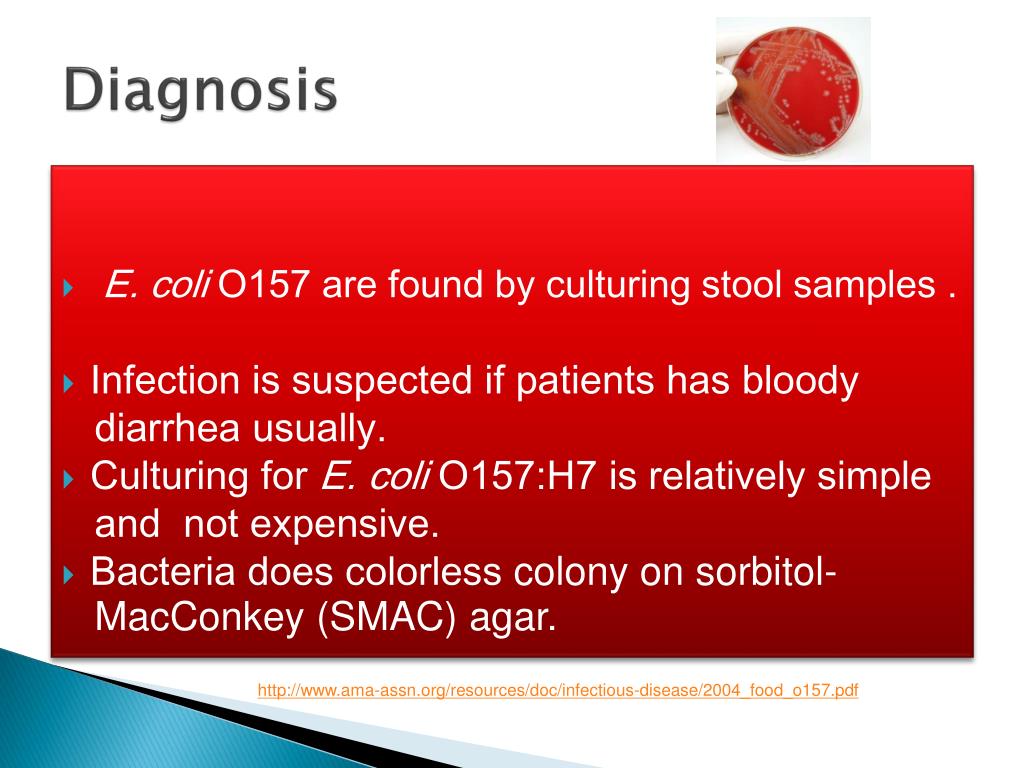 This strain can cause severe food poisoning because it produces Shiga toxin, which causes severe foodborne illness. All over the world, attention is focused on this particular microbe, since there have been so many outbreaks associated with it.
This strain can cause severe food poisoning because it produces Shiga toxin, which causes severe foodborne illness. All over the world, attention is focused on this particular microbe, since there have been so many outbreaks associated with it.
close
100%
– What foods can cause infection with this strain?
– These are all products that do not undergo additional heat treatment: hamburgers, freshly squeezed juice, yoghurts, cheeses, the same rolls. Vegetables and fruits can also be the cause of such diseases. The only effective way to kill bacteria in food products is heat treatment, pasteurization, etc.
– If Escherichia coli O157 is in the product, will anyone be infected?
– The risk of such diseases is very high in young children and the elderly. The incubation period lasts from three to eight days. Signs of the disease: spasms, diarrhea, which in some cases can be bloody. Further, hemolytic uremic syndrome develops (renal failure and low platelet and red blood cell counts). It has very serious consequences, so serious attention should be paid to this strain of E. coli.
It has very serious consequences, so serious attention should be paid to this strain of E. coli.
– It turns out that our control service is trying to find not a dangerous E. coli, but everything?
— The Russian approach is based on a more stringent microbiological risk assessment. We do not have such a meticulous division into strains.
It is believed that if we basically found E. coli, then among them there may be a dangerous one. This is a multifactorial story that speaks about the sanitary and hygienic conditions of food processing, preparation and storage, as well as the hygiene of personnel.
— E. coli contamination is considered faecal. Where does fecal contamination come from in rolls? Do cooks not wash their hands to this extent?
– Fecal pollution is a very old concept. It would be more correct to say: contamination by intestinal microflora. When slaughtering and processing animals, poultry, fish, etc. contamination with these bacteria occurs and is inevitable. For example, you take a carcass, remove the skin from it and start making semi-finished products from it. It is clear that what was in the intestines, what was formed by the microflora of the animal itself, can then be present in the product.
For example, you take a carcass, remove the skin from it and start making semi-finished products from it. It is clear that what was in the intestines, what was formed by the microflora of the animal itself, can then be present in the product.
However, when we find these microorganisms, we are still talking about the so-called “dirty hand disease”. They can get not only from raw materials, but also from equipment and from the hands of working personnel.
— Will there be E. coli in any food that is made by hand and not thermally processed?
– Quite often she will be there. The solution for manufacturers is only thorough sanitation and hygiene in the processing of raw materials. For example, when processing fruits and vegetables, they must be thoroughly washed, possibly even with soap. If these are cheeses, milk, it is necessary to do input control of raw materials. There is no other way.
– So if only 40% of the rolls contain E. coli, it’s not so bad, in general?
– When talking about percentages, it’s always about sampling.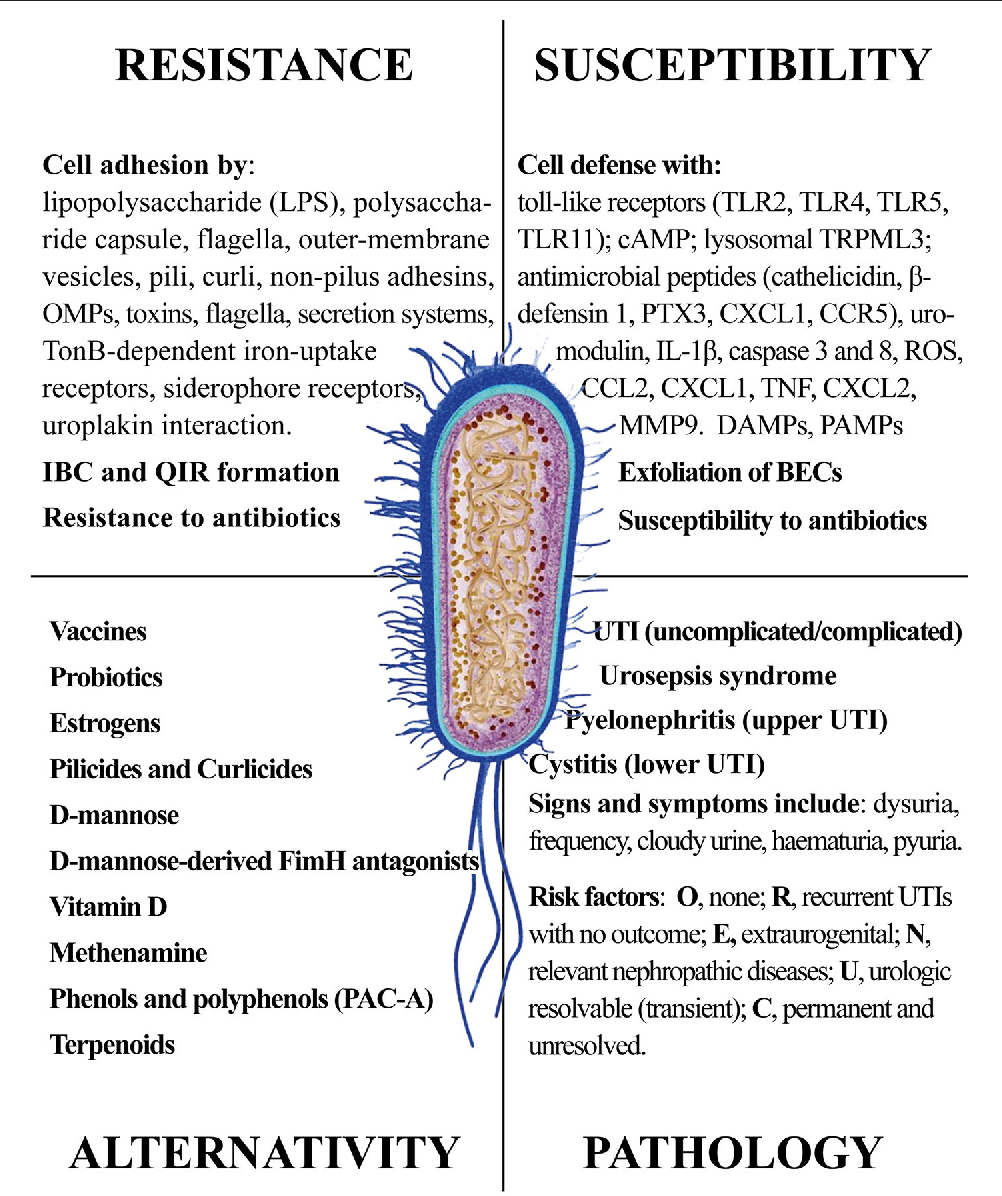 You need to look at the study itself. How many of these rolls were analyzed in total?
You need to look at the study itself. How many of these rolls were analyzed in total?
Rolls are a multi-component composite product, there have always been many questions and conversations about them, for example, how to change approaches to assessing E. coli bacteria?
In my opinion, in relation to such new products, the work that the specialists of the Institute of Nutrition did in the 80-90s should be carried out. Then a huge monitoring of food products was carried out, they studied them in detail, and established standards. New types of products are now being evaluated based on those approaches, as well as microbiological risk criteria.
– It turns out that in any rolls there will be a stick, but do you need it to be no more than the norm?
– Of course. Depending on what is contained in the composition of the product, there will be different standards. Abroad, the approach to the ready-to-eat group (ready-to-eat products) is very serious. It is these products that are in the zone of increased attention – they look at all pathogenic microorganisms that can cause diseases.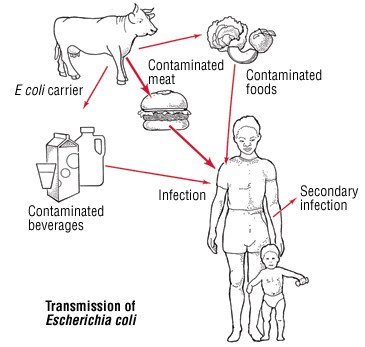
These foods (lettuce, beef, sprouts, etc.) are tested worldwide for E. coli O157. We don’t have that. At one time, the Institute of Nutrition developed documents on Shiga toxins, but the standard did not appear in the technical regulations. Now, if Roskachestvo specialists analyzed the rolls and said that they contain E. coli O157, this would indicate that 40% of the products on the market are pathogenic. Then you should be worried.
— Do they analyze E. Coli-O 157 somewhere in our country?
– Usually only in products that are exported. Not all laboratories in our country can analyze this pathogen. All microbiological laboratories have permission to work with certain microorganisms (according to their degree of danger). Most of the laboratories that analyze food products are licensed for the 3rd and 4th pathogenicity groups (less dangerous) E. coli O157, due to the Shiga toxin produced by it, fell into the 2nd pathogenicity group. To work with it, you need a completely different level of laboratories, which are much fewer in the country than those who can work with the 3rd and 4th groups.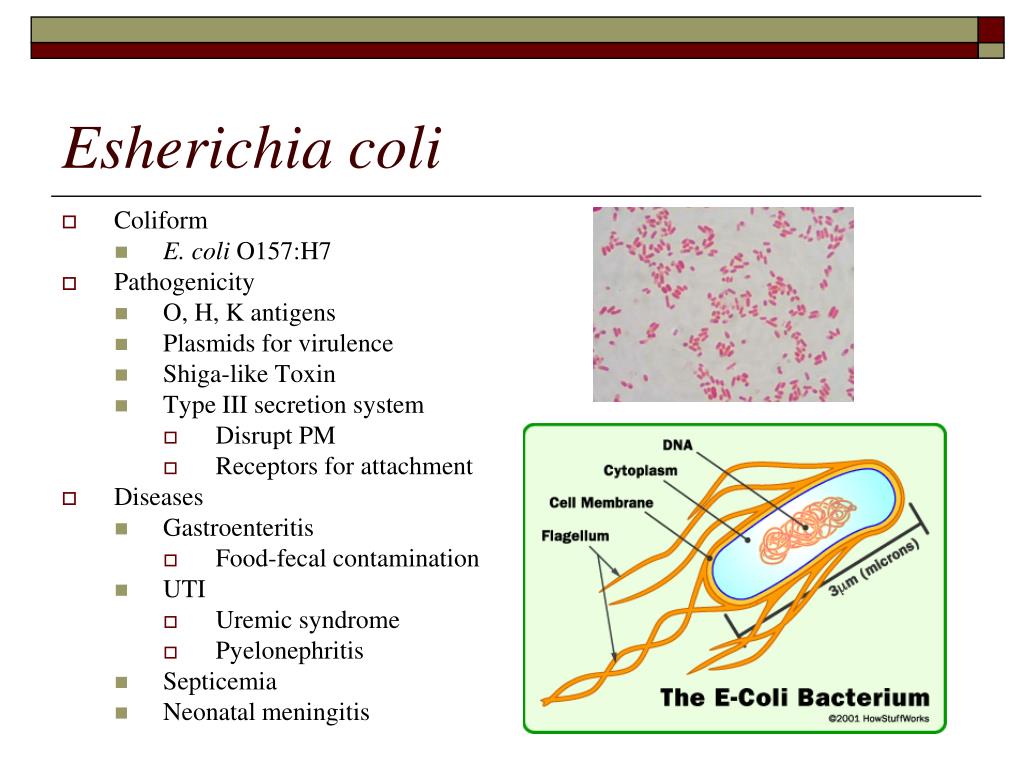 This is mainly part of the laboratories of Rospotrebnadzor, Rosselkhoznadzor. We do not have a large-scale assessment of these microbes – there is neither a standard nor the ability to analyze it, although there is a demand.
This is mainly part of the laboratories of Rospotrebnadzor, Rosselkhoznadzor. We do not have a large-scale assessment of these microbes – there is neither a standard nor the ability to analyze it, although there is a demand.
— What other bacteria are there that can cause serious illness?
– Listeria, Salmonella and Campylobacter jejuni. If you open European statistics, campylobacteriosis is the number one foodborne infection in humans. It is associated in most cases with poultry products. Often Campylobacter may be present in the raw material itself. If all this is in the kitchen where the cooks cook, then there is a high probability of cross-contamination. Therefore, it is important to store food properly.
In addition to bacteria, there are also viruses that also cause food poisoning. This is another topic that we are closely involved in. In particular, these are noroviruses – there are a lot of outbreaks caused by this pathogen. Quite a few types of foods – leafy salads, berries, a number of shellfish, including oysters – can be sources of norovirus. There is no control over noroviruses in our country yet, but we have developed research methods and conducted joint studies with Serbian colleagues, which show that such monitoring is needed.
There is no control over noroviruses in our country yet, but we have developed research methods and conducted joint studies with Serbian colleagues, which show that such monitoring is needed.
— What could potentially be contaminated with dangerous bacteria and viruses?
– Potentially dirty is always raw materials – what we prepare the product from, and potentially clean – raw materials that have undergone heat treatment. We have production standards – about 70 ° C, which ensure the destruction of harmful microorganisms. Poultry, meat – all products of animal origin have a fairly high risk for the presence of microorganisms. For them, it is better to have a separate board, wash it thoroughly with soap. However, one must understand that it is impossible to get rid of all microorganisms in the world, and it is not necessary.
Enterohemorrhagic e. coli (E. coli)
What is E. coli?
Escherichia coli (E. coli) is a widespread type of bacteria with hundreds of strains, most of which are harmless and are a natural part of the intestinal flora.
Enterohemorrhagic Escherichia coli (EHEC) are genetically modified strains of Escherichia coli bacteria or pathogenic bacterial strains that are the causative agents of epidemic outbreaks of hemorrhagic colitis in adults.
Main species of E. coli?
The genus Escherichia includes several species. One of them – E. coli causes two types of human diseases: extraintestinal (urinary tract lesions) and most often – acute intestinal.
Acute intestinal diseases are caused by:
- enterotoxigenic E. coli (ETEC),
- Enteroinvasive E. coli (EIEC),
- enteropathogenic E. coli (EPEC),
- enterohemorrhagic E. coli (EHEC).
Features of enterohemorrhagic E. coli (EHEC)?
EHEC produces toxins known as verotoxins or Shiga-like toxins. Shiga toxins Stx1 and Stx2 are the key damaging factor of Escherichia coli.
EHEC is transmitted to humans through contaminated food.
The number of EHEC bacteria increases at temperatures from 7°C to 50°C, the optimum temperature for propagation is 37°C. Some EHEC bacteria can grow in acidic foods with a pH of up to 4.4, as well as in foods with a minimum water activity (Aw) of 0.95.
Some EHEC bacteria can grow in acidic foods with a pH of up to 4.4, as well as in foods with a minimum water activity (Aw) of 0.95.
EHEC are killed when food is thoroughly cooked at or above 70°C.
Most bacterial strains of Escherichia coli, belonging to the genus Escherichia of the Enterobacteriaceae family, are part of the normal human intestinal microflora and are harmless.
Among strains of E. coli (EHEC), pathogenic strains synthesizing verotoxins (shiga-like toxins) are of particular importance. Enterohemorrhagic Escherichia coli (EHEC) includes the following highly pathogenic serotypes: O157:H7, O26, O103, O111, O145, etc.
E.coli O157:H7/O157 is a dangerous Escherichia coli, the main and most common representative of the enterohemorrhagic Escherichia coli group. The most significant EHEC serotype is E. coli O157:H7, but other serotypes are often responsible for sporadic cases and outbreaks.
Are all strains of E. coli harmful to humans?
Most strains of E. coli are harmless. However, some strains, such as enterohemorrhagic E. coli (EHEC), cause severe foodborne illness.
coli are harmless. However, some strains, such as enterohemorrhagic E. coli (EHEC), cause severe foodborne illness.
Sources of EHEC outbreaks?
Raw or undercooked minced meat products, raw milk and vegetables contaminated with faeces.
What are the symptoms of an illness caused by HENEC?
Symptoms: abdominal cramps and diarrhea, hemorrhagic colitis. Fever and vomiting are possible.
What is the incubation period?
The incubation period lasts from 3 to 8 days.
In what environment does HEC O157:H7 serotype develop?
The reservoir of this pathogenic microorganism is cattle, sheep, goats, deer, pigs, horses, rabbits, dogs, cats, birds (chickens, turkeys).
How is the EHEC O157:H7 serotype transmitted to humans?
- Through consumption of contaminated foods such as raw or undercooked ground meats and raw milk.
- Through faecal-contaminated water and other foods.
- Due to cross contamination during preparation.




